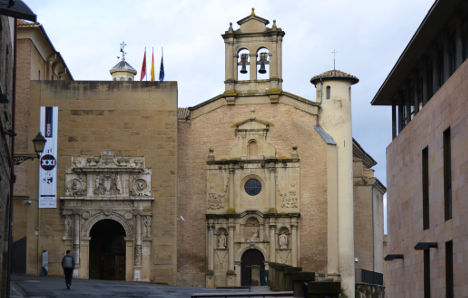There are plenty of reasons to visit the northern city of Pamplona besides the running of the bulls. Also called Iruña in Basque, this city is the former capital of the Kingdom of Navarra and locals take pride in that.
Brightly painted houses along narrow, cobblestone streets with balconies nearly close enough for people to reach across to one another.
READ ALSO:How to survive running with the bulls in Pamplona
The Local looks at some of the many ways to enjoy Pamplona outside of San Fermin.
The Gothic churches
The main cathedral of Pamplona, Santa Maria, is a Gothic temple and its construction began as far back as 1394.
But there are other churches that are even older: Both the medieval San Nicolas and San Saturnino churches having histories dating back to the 1100s.
The Museo de Navarra
 Photo: Joanbanjo/Wikimedia Commons.
Photo: Joanbanjo/Wikimedia Commons.
Another great site to visit architecturally and historically speaking, this museum is located inside a 16th-century hospital. The art museum features works that are prehistoric, Roman as well as a work by Goya.
Plus it’s super cheap at just €2 for adults, and Saturday afternoons and Sundays for free.
The parks
Pamplona has a number of beautiful green parks and gardens, old and new, like the Taconera park, dating back to the 1800s. There are a number of aging arches, statues, fountains and more adorning the gardens, as well as a small zoo with radiant peacocks.
Another lovely patch of green to discover is the Yamaguchi park, which was designed in 1997 by Japanese landscape architects and is the most modern park in the city.
But the Parque del Mundo and the Arga park are also worth a visit.
The Ciudadela (Citadel)
This Renaissance fortification was built to protect Pamplona from attacking enemies in 1571, in particular the French.
The Citadel spans 280,000 square metres with green spaces, moats, pavilions, and much more.
The food
And of course, you can't forget the food. Being in the north and in an area with such a strong Basque culture, you're bound to find food with names you may be unfamiliar with in the rest of the country.
When it's not crowded with wine-drunk and soaked revellers for San Fermin, the central Plaza del Castillo has a number of restaurants.
Look out for garroticos – little croissant-like pastries with chocolate inside – and try the variety of pintxos, like tapas, that restaurants will offer.
Another typical Pamplona dish is cordero en chilindrón, which is a stew of lamb, tomato and vegetables. Or if you like peppers, try pimientos del piquillo, often stuffed with meat, seafood or cheese.
The traditional sausage chistorra is another regional dish, often served with fried egg and potatoes.



 Please whitelist us to continue reading.
Please whitelist us to continue reading.
Member comments